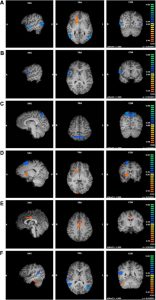Mindfulness is Associated with Improved Functional Connectivity in the Brain
By John M. de Castro, Ph.D.
“mindfulness meditation training increases resting state connectivity between top-down executive control regions, highlighting an important mechanism through which it reduces stress levels.” – Daniel Reed
The nervous system is a dynamic entity, constantly changing and adapting to the environment. It will change size, activity, and connectivity in response to experience. These changes in the brain are called neuroplasticity. Over the last decade neuroscience has been studying the effects of contemplative practices on the brain and has identified neuroplastic changes in widespread area. and have found that meditation practice appears to mold and change the brain, producing psychological, physical, and spiritual benefits.
This suggests that the individual’s trait of mindfulness may be associated with differing functional connectivity in the brain. In today’s Research News article “Trait Mindfulness and Functional Connectivity in Cognitive and Attentional Resting State Networks.” (See summary below or view the full text of the study at: https://www.ncbi.nlm.nih.gov/pmc/articles/PMC6473082/), Parkinson and colleagues recruited undergraduate students and measured them for mindfulness including the observing, describing, non-reacting, acting with awareness, and non-judging facets. Functional connectivity of their brains was measured with Magnetic Resonance Imaging (MRI).
They found that the higher the students’ levels of trait mindfulness and its facets the lower the functional connectivity in a set of structures termed the Default Mode Network (DMN) that has been associated with mind wandering, rumination, and self-referential thinking. Conversely, they found that the higher the students’ levels of trait mindfulness the higher the functional connectivity of the Anterior Cingulate Cortex, a structure associated with self-regulation, the Dorsal Medial Prefrontal Cortex, a structure associated with attentional control and high level thinking (executive function), the Insula, a structure associated with emotion regulation, and the Prefrontal Gyrus, a structure associated with sensorimotor processing.
Hence they found that there was increased functional connectivity in structures that appear to underlie the relationships of mindfulness with attention, emotion regulation, sensory processing, self-regulation, and high level thinking and decreased functional connectivity in structures that appear to underlie the processes of mind wandering and rumination that are weakened with mindfulness. In many ways, the functional connectivity of the students with high mindfulness resembles that of experienced meditators. This suggests that mindfulness and its benefits are associated with strengthened neural processing in specific areas of the brain.
Hence, mindfulness is associated with improved functional connectivity in the brain.
“Just 11 hours of learning a meditation technique induce positive structural changes in brain connectivity by boosting efficiency in a part of the brain that helps a person regulate behavior in accordance with their goals.” – University of Oregon
CMCS – Center for Mindfulness and Contemplative Studies
This and other Contemplative Studies posts are also available on Google+ https://plus.google.com/106784388191201299496/posts and on Twitter @MindfulResearch
Study Summary
Parkinson TD, Kornelsen J, Smith SD. Trait Mindfulness and Functional Connectivity in Cognitive and Attentional Resting State Networks. Front Hum Neurosci. 2019 Apr 12;13:112. doi: 10.3389/fnhum.2019.00112. PubMed PMID: 31031607; PubMed Central PMCID: PMC6473082.
Abstract
Mindfulness has been described as an orienting of attention to the present moment, with openness and compassion. Individuals displaying high trait mindfulness exhibit this tendency as a more permanent personality attribute. Given the numerous physical and mental health benefits associated with mindfulness, there is a great interest in understanding the neural substrates of this trait. The purpose of the current research was to examine how individual differences in trait mindfulness associated with functional connectivity in five resting-state networks related to cognition and attention: the default mode network (DMN), the salience network (SN), the central executive network (CEN), and the dorsal and ventral attention networks (DAN and VAN). Twenty-eight undergraduate participants completed the Five-Facet Mindfulness Questionnaire (FFMQ), a self-report measure of trait mindfulness which also provides scores on five of its sub-categories (Observing, Describing, Acting with Awareness, Non-judging of Inner Experience, and Non-reactivity to Inner Experience). Participants then underwent a structural MRI scan and a 7-min resting state functional MRI scan. Resting-state data were analyzed using independent-component analyses. An analysis of covariance (ANCOVA) was performed to determine the relationship between each resting state network and each FFMQ score. These analyses indicated that: (1) trait mindfulness and its facets showed increased functional connectivity with neural regions related to attentional control, interoception, and executive function; and (2) trait mindfulness and its facets showed decreased functional connectivity with neural regions related to self-referential processing and mind wandering. These patterns of functional connectivity are consistent with some of the benefits of mindfulness—enhanced attention, self-regulation, and focus on present experience. This study provides support for the notion that non-judgmental attention to the present moment facilitates the integration of regions in neural networks that are related to cognition, attention, and sensation.
https://www.ncbi.nlm.nih.gov/pmc/articles/PMC6473082/
